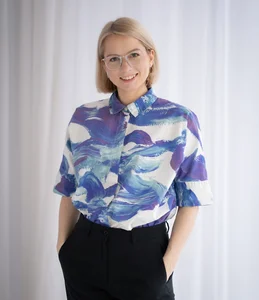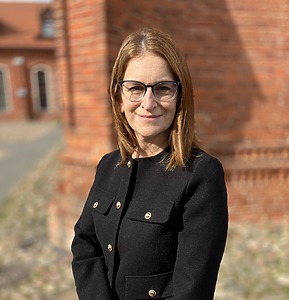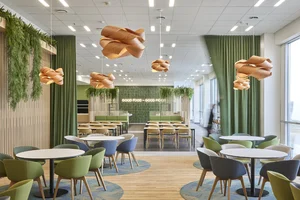Today, companies typically allocate around 60% of their office space to workplaces, with the rest of the space used for leisure, recreation and sports. Businesses note that a comfortable working environment is a necessity because it helps people feel good and fulfil their potential. An attractive office is a must not only for private companies but also for the public sector when competing for talented employees.
Evelina Meilienė, Vice-Rector of Community Affairs at Kaunas University of Technology (KTU), one of the largest employers in Kaunas, notes that one of the biggest challenges of team building and collaboration in large organisations is the number of employees. They know each other well in terms of functions and positions but rarely can interact in a less formal setting, to share ideas or daily experiences that help to form a human bond.
From attractive recreational spaces to sports grounds
Attractive workplaces are a daily reality not only for private companies but also for the public sector. KTU, being one of the largest employers in Kaunas, is creating changes not only in science and studies but also in human resources management. According to Meilienė, the University offers many initiatives to the community not only in terms of infrastructure but also competences and organisational culture.
“We are renovating old or non-functional spaces in our departments to adapt them to the needs of the community. We have created leisure and community spaces for the KTU community at the Faculties of Civil Engineering and Architecture, Mechanical and Design Engineering. The Student Information Centre was designed considering not only the functionality of the premises but also the needs and convenience of the students and staff,” says Meilienė.
The KTU Campus Library also perfectly meets the needs of the KTU community, as it offers spaces for reading, individual meetings and events, as well as an amphitheatrical auditorium, which is ideal for open community lectures.
“In the Central Administration Building, we have combined several smaller rooms to create a community space for staff lunch breaks or relaxation moments. The latter also includes an integrated children’s play area. In the coming years, leisure spaces will be created in other academic and administrative units of KTU as well,” says Meilienė.
Employees’ views are key
While creating an attractive working environment the employees’ involvement is very important.
She believes that the workplace should first and foremost meet the desires of employees to have a more comfortable environment, as offices are not just a place to connect to the electricity grid. It’s a place for mutual communication, creativity and well-being.
“Employees’ opinions are important to us when it comes to furnishing, which is why we organise home office design consultations for remote working. In the office itself, the combination of private offices, open spaces and flexible meeting rooms allows employees to choose where they want to work and collaborate,” says Zvaigzne.
Modern workplaces place a great deal of emphasis on active physical activity in addition to leisure gatherings. Gyms are being built in office complexes, and sports grounds are being opened near offices, where employees often gather all year round.
“Our employees who want to work out outdoors can use the multi-functional bench located near the entrance. It has a QR code on it, which, when scanned, allows employees to view workout instructions for all muscle groups. In addition to the sports areas, the office also has a roof terrace where smaller or larger events can be organized,” says Zvaigzne.






